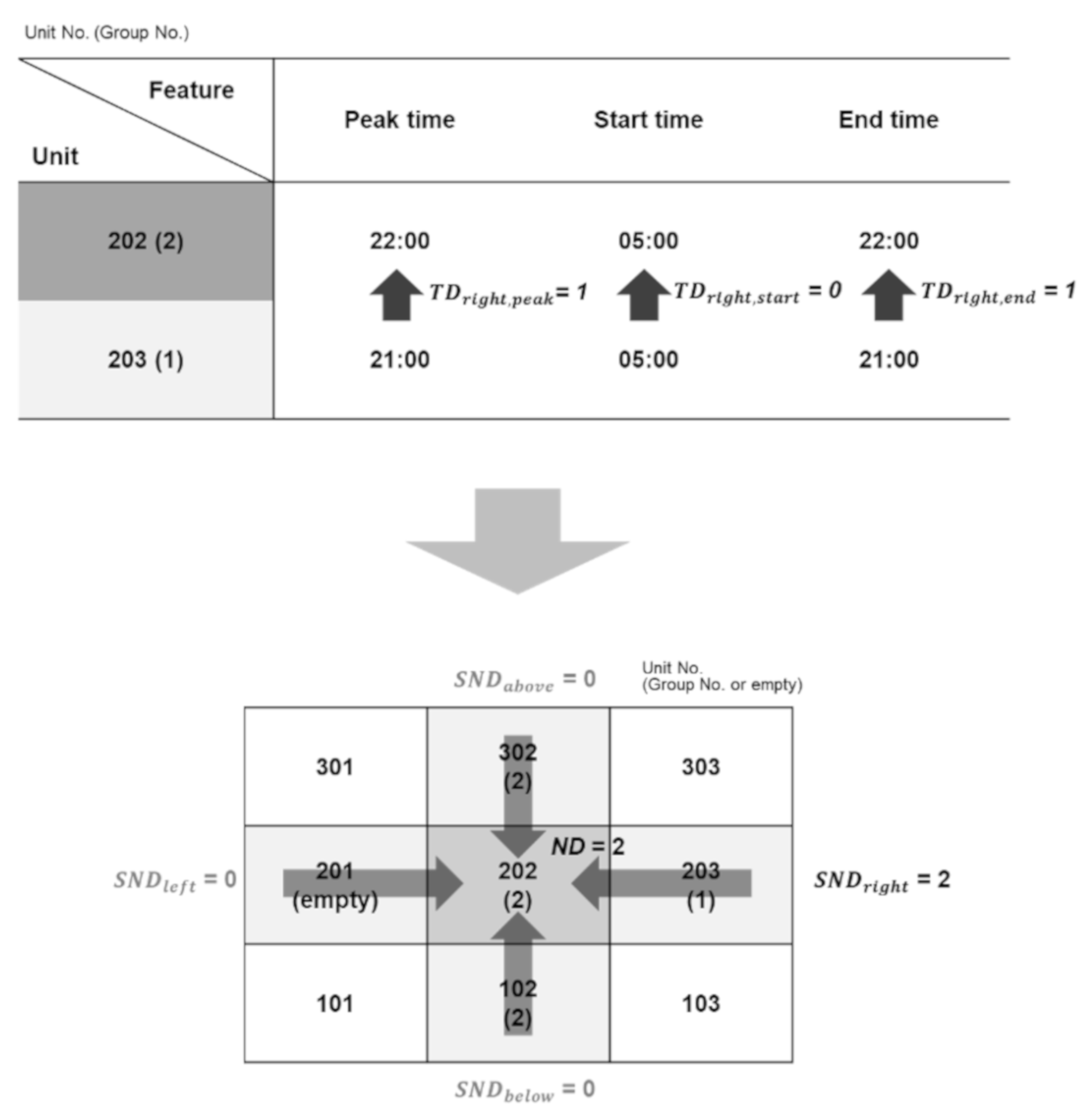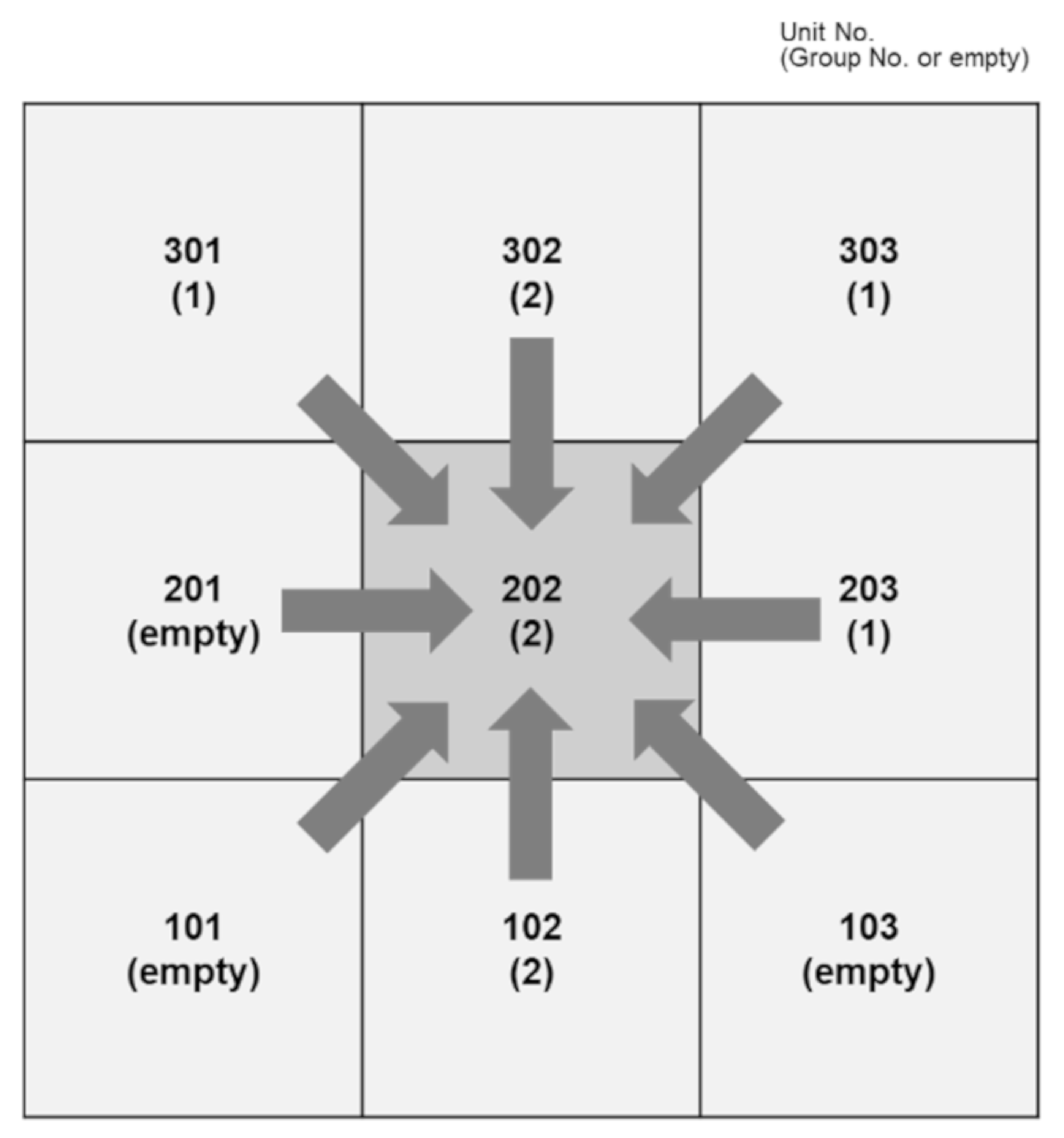Utilizing Electricity Consumption Data to Assess the Noise Discomfort Caused by Electrical Appliances between Neighbors: A Case Study of a Campus Apartment Building
Abstract
1. Introduction
2. Literature Review
3. Method
4. Results through a Case Study of a Campus Apartment Building at POSTECH
4.1. Data Collection and Preprocessing
4.2. Residential Units Clustering
4.3. ND Modeling
4.4. ND Evaluation
5. Discussion
5.1. Variations in the ND Assessment Model
+ SNDleftdown + SNDleftup + SNDrightdown + SNDrightup,
5.2. Measures for ND Alleviation
6. Conclusions
Author Contributions
Funding
Conflicts of Interest
References
- Razavi, R.; Gharipour, A.; Fleury, M.; Akpan, I.J. Occupancy detection of residential buildings using smart meter data: A large-scale study. Energy Build. 2019, 183, 195–208. [Google Scholar] [CrossRef]
- Azadeh, A.; Saberi, M.; Gitiforouz, A.; Saberi, Z. A hybrid simulation-adaptive network based fuzzy inference system for improvement of electricity consumption estimation. Expert Syst. Appl. 2009, 36, 11108–11117. [Google Scholar] [CrossRef]
- Kwac, J.; Flora, J.; Rajagopal, R. Household energy consumption segmentation using hourly data. IEEE Trans. Smart Grid 2014, 5, 420–430. [Google Scholar] [CrossRef]
- Doukas, H.; Patlitzianas, K.D.; Iatropoulos, K.; Psarras, J. Intelligent building energy management system using rule sets. Build. Environ. 2007, 42, 3562–3569. [Google Scholar] [CrossRef]
- Li, X.; Bowers, C.P.; Schnier, T. Classification of energy consumption in buildings with outlier detection. IEEE Trans. Ind. Electron. 2009, 57, 3639–3644. [Google Scholar] [CrossRef]
- Garg, N.; Maji, S. A retrospective view of noise pollution control policy in India: Status, proposed revisions and control measures. Curr. Sci. 2016, 111, 29–38. [Google Scholar] [CrossRef]
- Nagi, G.; Dhillon, M.K.; Bansal, A.S.; Dhaliwal, G.S. Extent of noise pollution from household equipment and appliances. Indian J. Ecol. 1993, 20, 152–156. [Google Scholar]
- Firdaus, G.; Ahmad, A. Noise pollution and human health: A case study of municipal corporation of Delhi. Indoor Built Environ. 2010, 19, 648–656. [Google Scholar] [CrossRef]
- Fatima, S.; Mohanty, A.R. Noise Control of Home Appliances—The Green Way. Noise Vib. Worldw. 2012, 43, 26–34. [Google Scholar]
- Ryu, J.K.; Jeon, J.Y. Influence of noise sensitivity on annoyance of indoor and outdoor noises in residential buildings. Appl. Acoust. 2011, 72, 336–340. [Google Scholar] [CrossRef]
- Gjestland, T.; Gelderblom, F.B.; Fidell, S. Sample size implications for calculations of community tolerance level values from social surveys of noise-induced annoyance. J. Acoust. Soc. Am. 2019, 146, 1212–1218. [Google Scholar] [CrossRef] [PubMed]
- Park, S.H.; Lee, P.J. How residents in multifamily housing cope with neighbour noise: The role of attitude towards the neighbours. J. Community Psychol. 2019, 47, 1909–1925. [Google Scholar] [CrossRef] [PubMed]
- Sanquist, T.F.; Orr, H.; Shui, B.; Bittner, A.C. Lifestyle factors in US residential electricity consumption. Energy Policy 2012, 42, 354–364. [Google Scholar] [CrossRef]
- Lu, S.C.; Chang, K.C.; Lin, W.M.; Chung, K.M. Energy Usage of Residents on Offshore Islands in Taiwan. Sustainability 2015, 7, 6652–6664. [Google Scholar] [CrossRef]
- Bijsterveld, K. “The City of Din”: Decibels, Noise, and Neighbors in the Netherlands, 1910–1980. Osiris 2003, 18, 173–193. [Google Scholar] [CrossRef]
- Stankovic, L.; Stankovic, V.; Liao, J.; Wilson, C. Measuring the energy intensity of domestic activities from smart meter data. Appl. Energy 2016, 183, 1565–1580. [Google Scholar] [CrossRef]
- Yassine, A.; Singh, S.; Alamri, A. Mining human activity patterns from smart home big data for health care applications. IEEE Access 2017, 5, 13131–13141. [Google Scholar] [CrossRef]
- Prudenzi, A. A neuron nets based procedure for identifying domestic appliances pattern-of-use from energy recordings at meter panel. In Proceedings of the 2002 IEEE Power Engineering Society Winter Meeting, New York, NY, USA, 27–31 January 2002; IEEE: Piscataway, NJ, USA, 2002. [Google Scholar]
- Firth, S.; Lomas, K.; Wright, A.; Wall, R. Identifying trends in the use of domestic appliances from household electricity consumption measurements. Energy Build. 2008, 40, 926–936. [Google Scholar] [CrossRef]
- Basu, K.; Hawarah, L.; Arghira, N.; Joumaa, H.; Ploix, S. A prediction system for home appliance usage. Energy Build. 2013, 67, 668–679. [Google Scholar] [CrossRef]
- Zheng, Z.; Chen, H.; Luo, X. A supervised event-based non-intrusive load monitoring for non-linear appliances. Sustainability 2018, 10, 1001. [Google Scholar] [CrossRef]
- Shin, C.; Lee, E.; Han, J.; Yim, J.; Rhee, W.; Lee, H. The ENERTALK dataset, 15 Hz electricity consumption data from 22 houses in Korea. Sci. Data 2019, 6, 1–13. [Google Scholar] [CrossRef] [PubMed]
- Epp, S.; Konz, S. Home appliance noise: Annoyance and speech interference. Home Econ. Res. J. 1975, 3, 205–209. [Google Scholar] [CrossRef]
- Jackson, G.M.; Leventhall, H.G. Household appliance noise. Appl. Acoust. 1975, 8, 101–118. [Google Scholar] [CrossRef]
- Jeon, J.Y.; You, J.; Chang, H.Y. Sound radiation and sound quality characteristics of refrigerator noise in real living environments. Appl. Acoust. 2007, 68, 1118–1134. [Google Scholar] [CrossRef]
- Bae, S.G.; Lee, W.H.; Bae, M.J. A Study on Sound Characteristics of Home appliances Noise using Psychoacoustics Parameters. Int. J. Eng. Technol. 2016, 8, 1606–1610. [Google Scholar] [CrossRef][Green Version]
- Lee, J. Neighborhood Noise. In Noise Pollution; IntechOpen: London, UK, 2020; Available online: https://www.intechopen.com/online-first/neighborhood-noise (accessed on 26 September 2020).
- Mutiara, M. Noise Complaints between Japanese Neighbors and Migrants in Rural Japan: From the Perspectives of Noisemakers. Soc. Sci. 2018, 7, 268. [Google Scholar] [CrossRef]
- Hume, K.; Gregg, M.; Thomas, C.; Terranova, D. Complaints caused by aircraft operations: An assessment of annoyance by noise level and time of day. J. Air Transp. 2003, 9, 153–160. [Google Scholar] [CrossRef]
- Ali, M.; Alqahtani, A.; Jones, M.W.; Xie, X. Clustering and Classification for Time Series Data in Visual Analytics: A Survey. IEEE Access 2019, 7, 181314–181338. [Google Scholar] [CrossRef]
- Aghabozorgi, S.; Shirkhorshidi, A.S.; Wah, T.Y. Time-series clustering–a decade review. Inf. Syst. 2015, 53, 16–38. [Google Scholar] [CrossRef]
- Ziegler, H.; Jenny, M.; Gruse, T.; Keim, D.A. Visual market sector analysis for financial time series data. In Proceedings of the 2010 IEEE Symposium on Visual Analytics Science and Technology, Salt Lake City, UT, USA, 24–29 October 2010; pp. 83–90. [Google Scholar]
- Goutte, C.; Toft, P.; Rostrup, E.; Nielsen, F.A.; Hansen, L.K. On clustering fMRI time series. NeuroImage 1999, 9, 298–310. [Google Scholar] [CrossRef]
- Mao, S.; Qiu, S.; Li, T.; Tang, M.; Deng, H.; Zheng, H. Using Characteristic Energy to Study Rural Ethnic Minorities’ Household Energy Consumption and Its Impact Factors in Chongqing, China. Sustainability 2020, 12, 6898. [Google Scholar] [CrossRef]
- Martinez-Pabon, M.; Eveleigh, T.; Tanju, B. Optimizing residential energy management using an autonomous scheduler system. Expert Syst. Appl. 2018, 96, 373–387. [Google Scholar] [CrossRef]
- Ruiz, L.G.B.; Pegalajar, M.C.; Arcucci, R.; Molina-Solana, M. A Time-Series Clustering Methodology for Knowledge Extraction in Energy Consumption Data. Expert Syst. Appl. 2020, 160, 113731. [Google Scholar] [CrossRef]
- McLoughlin, F.; Duffy, A.; Conlon, M. A clustering approach to domestic electricity load profile characterisation using smart metering data. Appl. Energy 2015, 141, 190–199. [Google Scholar] [CrossRef]
- Kwac, J.; Flora, J.; Rajagopal, R. Lifestyle segmentation based on energy consumption data. IEEE Trans. Smart Grid 2016, 9, 2409–2418. [Google Scholar] [CrossRef]
- Mohmed, G.; Lotfi, A.; Pourabdollah, A. Long short-term memory fuzzy finite state machine for human activity modelling. In Proceedings of the 2019 ACM International Conference on Pervasive Technologies Related to Assistive Environments, Rhodes, Greece, 5–7 June 2019; pp. 561–567. [Google Scholar]
- Yilmaz, S.; Chambers, J.; Patel, M.K. Comparison of clustering approaches for domestic electricity load profile characterisation-Implications for demand side management. Energy 2019, 180, 665–677. [Google Scholar] [CrossRef]
- Montoya-Belmonte, J.; Navarro, J.M. Long-Term Temporal Analysis of Psychoacoustic Parameters of the Acoustic Environment in a University Campus Using a Wireless Acoustic Sensor Network. Sustainability 2020, 12, 7406. [Google Scholar] [CrossRef]
- Diao, L.; Sun, Y.; Chen, Z.; Chen, J. Modeling energy consumption in residential buildings: A bottom-up analysis based on occupant behavior pattern clustering and stochastic simulation. Energy Build. 2017, 147, 47–66. [Google Scholar] [CrossRef]
- Zhou, X.; Yan, D.; Hong, T.; Ren, X. Data analysis and stochastic modeling of lighting energy use in large office buildings in China. Energy Build. 2015, 86, 275–287. [Google Scholar] [CrossRef]
- Chicco, G.; Napoli, R.; Piglione, F. Comparisons among clustering techniques for electricity customer classification. IEEE Trans. Power Syst. 2006, 21, 933–940. [Google Scholar] [CrossRef]
- Wen, L.; Zhou, K.; Yang, S. A shape-based clustering method for pattern recognition of residential electricity consumption. J. Clean. Prod. 2019, 212, 475–488. [Google Scholar] [CrossRef]
- Seem, J.E. Pattern recognition algorithm for determining days of the week with similar energy consumption profiles. Energy Build. 2005, 37, 127–139. [Google Scholar] [CrossRef]
- Gouveia, J.P.; Seixas, J. Unraveling electricity consumption profiles in households through clusters: Combining smart meters and door-to-door surveys. Energy Build. 2016, 116, 666–676. [Google Scholar] [CrossRef]
- Yildiz, B.; Bilbao, J.I.; Dore, J.; Sproul, A.B. Recent advances in the analysis of residential electricity consumption and applications of smart meter data. Appl. Energy 2017, 208, 402–427. [Google Scholar] [CrossRef]
- Deb, C.; Frei, M.; Hofer, J.; Schlueter, A. Automated load disaggregation for residences with electrical resistance heating. Energy Build. 2019, 182, 61–74. [Google Scholar] [CrossRef]
- Kanungo, T.; Mount, D.M.; Netanyahu, N.S.; Piatko, C.D.; Silverman, R.; Wu, A.Y. An efficient k-means clustering algorithm: Analysis and implementation. IEEE Trans. Pattern Anal. Mach. Intell. 2002, 24, 881–892. [Google Scholar] [CrossRef]
- Rousseeuw, P.J. Silhouettes: A graphical aid to the interpretation and validation of cluster analysis. J. Comput. Appl. Math. 1987, 20, 53–65. [Google Scholar] [CrossRef]
- Burney, S.A.; Tariq, H. K-means cluster analysis for image segmentation. Int. J. Comput. Appl. 2014, 96, 1–8. [Google Scholar]
- Vasas, V.; Peng, F.; MaBouDi, H.; Chittka, L. Randomly weighted receptor inputs can explain the large diversity of colour-coding neurons in the bee visual system. Sci. Rep. 2019, 9, 8330. [Google Scholar] [CrossRef] [PubMed]
- Şentop Dümen, A.; Tamer Bayazıt, N. Enforcement of acoustic performance assessment in residential buildings and occupant satisfaction. Build. Res. Inf. 2020, 1–20. [Google Scholar] [CrossRef]
- Li, K.; Ma, Z.; Robinson, D.; Ma, J. Identification of typical building daily electricity usage profiles using Gaussian mixture model-based clustering and hierarchical clustering. Appl. Energy 2018, 231, 331–342. [Google Scholar] [CrossRef]
- Zhou, K.; Yang, S.; Shao, Z. Household monthly electricity consumption pattern mining: A fuzzy clustering-based model and a case study. J. Clean. Prod. 2017, 141, 900–908. [Google Scholar] [CrossRef]
- Omran, M.G.; Engelbrecht, A.P.; Salman, A. An overview of clustering methods. Intell. Data Anal. 2007, 11, 583–605. [Google Scholar] [CrossRef]
- Hart, G.W. Nonintrusive appliance load monitoring. Proc. IEEE 1992, 80, 1870–1891. [Google Scholar] [CrossRef]






| Feature | Peak Time | Start Time | End Time | |
|---|---|---|---|---|
| Group | ||||
| Group 1 | 21:00 | 5:00 | 21:00 | |
| Group 2 | 22:00 | 5:00 | 22:00 | |
| Group 3 | 18:00 | 5:00 | 19:00 | |
Publisher’s Note: MDPI stays neutral with regard to jurisdictional claims in published maps and institutional affiliations. |
© 2020 by the authors. Licensee MDPI, Basel, Switzerland. This article is an open access article distributed under the terms and conditions of the Creative Commons Attribution (CC BY) license (http://creativecommons.org/licenses/by/4.0/).
Share and Cite
Ryu, D.-H.; Kim, R.-H.; Choi, S.-H.; Kim, K.-J.; Ko, Y.M.; Kim, Y.-J.; Song, M.; Choi, D.G. Utilizing Electricity Consumption Data to Assess the Noise Discomfort Caused by Electrical Appliances between Neighbors: A Case Study of a Campus Apartment Building. Sustainability 2020, 12, 8704. https://doi.org/10.3390/su12208704
Ryu D-H, Kim R-H, Choi S-H, Kim K-J, Ko YM, Kim Y-J, Song M, Choi DG. Utilizing Electricity Consumption Data to Assess the Noise Discomfort Caused by Electrical Appliances between Neighbors: A Case Study of a Campus Apartment Building. Sustainability. 2020; 12(20):8704. https://doi.org/10.3390/su12208704
Chicago/Turabian StyleRyu, Do-Hyeon, Ryu-Hee Kim, Seung-Hyun Choi, Kwang-Jae Kim, Young Myoung Ko, Young-Jin Kim, Minseok Song, and Dong Gu Choi. 2020. "Utilizing Electricity Consumption Data to Assess the Noise Discomfort Caused by Electrical Appliances between Neighbors: A Case Study of a Campus Apartment Building" Sustainability 12, no. 20: 8704. https://doi.org/10.3390/su12208704
APA StyleRyu, D.-H., Kim, R.-H., Choi, S.-H., Kim, K.-J., Ko, Y. M., Kim, Y.-J., Song, M., & Choi, D. G. (2020). Utilizing Electricity Consumption Data to Assess the Noise Discomfort Caused by Electrical Appliances between Neighbors: A Case Study of a Campus Apartment Building. Sustainability, 12(20), 8704. https://doi.org/10.3390/su12208704





